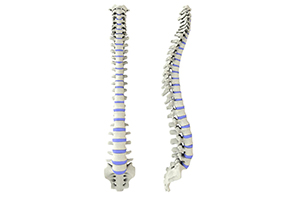Health Blog
Common cause of LBP can disappear spontaneously without surgery

Too much variation in statistics due to different classifications
Low back pain (LBP) is one of the most common medical conditions in the general population. Of its many possible causes, one of the most frequent is called lumbar intervertebral disc herniation, which is when a spinal disc degenerates and breaks down, leading to pain in the back that often runs to the leg. Fortunately, between 60-90% of lumbar disc herniations can be treated conservatively (non-surgically) and lead to positive outcomes for patients, and in some cases the herniation can be reduced and completely resolved. However, statistics vary greatly on this figure, with the percentage of disc herniations reduced in size ranging from 35-100% of patients over a period of between 3-40 months. These statistics vary due to different classifications of disc herniation by different researchers, but clearer figures are needed, so a powerful study called a systematic review was conducted on all available literature on the topic.
Nine studies on disc herniation are reviewed
A total of four medical databases were searched for relevant studies on conservative treatment for disc herniation, which could've included pain medications, physical therapy, exercise or injections. This search led to 31 studies being identified that fit the necessary criteria, with nine of these being used in the systematic review. These selected studies were then reviewed and used to calculate the probability of discs that regressed and/or were completely resolved.
Probability varies based on specific type of herniated disc
Results showed that lumbar disc herniation can in fact regress, or disappear completely, without surgery. The probability of this spontaneous regression occurring varied widely based on the specific type of disc herniation present. It ranged from as high as 96% for disc sequestrations to 13% for disc bulges. Overall, it was found that about 43% of sequestrated discs would completely resolve over time compared to only 15% of extruded discs. Most spontaneous disc regression happened within the first year, but in some cases regression was noticed as early as two or three months. These results suggest that in general, surgery does not seem to be needed to effectively treat all lumbar disc herniations, and many cases can be resolved completely with conservative treatment such as physical therapy, depending on the specific type of herniation.
-As reported in the February '15 issue of the Clinical Rehabilitation
November 25, 2016
Back to Health BlogHEALTH BLOG
- Exercise Therapy May Provide Relief for Chemotherapy-Related Issues
- Unlocking Relief From Elbow Pain With Hands-On Therapy and Exercise
- Are Deep Squats Really as Bad as We Think?
- Reclaiming Your Grip: The Power of Hands-On Therapy for Tennis Elbow
- Runners Can Overcome a Common Knee Condition With Physical Therapy
- How Physical Therapy Can Help Older Adults Stay on Their Feet
- What You Need to Know About Alcohol and Heart Health
- Exercise Therapy Provides Strong Evidence of Its Effectiveness
- Strength in Age: The Power of Resistance Training for Older Adults
- Hip Strength and Groin Pain: What Athletes Need to Know
RECENT ARTICLES

- 11 Possible Reasons Your Back HurtsJune 22, 2020

- What Conditions Can a Chiropractor Treat?May 25, 2020

- A Simple Guide to Better PostureApril 30, 2020

- Is Acupuncture Right for Me When I’m Afraid of Needles?March 30, 2020

- Stretching Done Right — How and When to StretchFebruary 26, 2020

